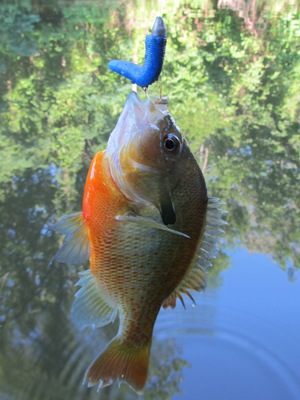Although soft plastic worm bodies are used predominately for largemouth bass fishing, they can also be useful for catching trophy-class sunfish, crappie, and other panfish. Very little in extra tackle is usually required to rig for panfish since most anglers keep a collection of plastic worms and other soft bodies in a wide range of colors, shapes, and sizes.
When rigging worm bodies and soft plastics for panfish, hooks and overall length should be downsized somewhat. To produce smaller rigs for panfish, full sized worms can be shortened and matched to a 1/0 or smaller worm hook. By varying the length of lures, anglers can focus on specific size classes of fish. Traditional style worms as well as slug type bodies all work, with shapes, colors, and other characteristics subject to experimentation.
Several worm rigs are known to be effective, with each style having its special applications. In some situations, only a hook and worm is required. Unweighted bodies work best when long casts are not required and when little or no depth is desired. These rigs work well when aggressively feeding fish are located in dense vegetation. In some situations, anglers need only to find an opening and cast their lure accurately in order to solicit a strike.
Another very common setup is the Texas rig. To rig a worm, slug, or other soft plastic body Texas style, a bullet sinker is added to the line above the hook. When targeting panfish, anglers usually employ the lightest possible weight, with 1/16 oz. being the most common.
A third choice for rigging plastic worm bodies is the Carolina rig. In this configuration, the bullet sinker is added to the line above a small swivel. From the swivel, a section of leader is used to separate the hook from the swivel by 18-36 inches. The Carolina rig has dozens of applications, even when used with soft plastic worms or other bodies.
Although the location of the weight might seem unimportant to novice anglers, the differences become quite apparent when the two rigs are fished in clear water conditions. The Carolina rig has a much different action when jigged, as the worm tends to sink and rise at a much different rate than its accompanying weight. The exact behavior of the worm will vary greatly depending on bullet sinker size, leader length, lure buoyancy, and retrieval rate. Heavy worms will cast farther and hug the bottom more while neutral or buoyant worms will tend to orient above the weight.
Both Texas and Carolina rigs offer advantages when targeting panfish. Both rigs are more resistant to snagging and fouling than many other lure designs. They can be casted, trolled or jigged. When fishing these rigs for panfish, anglers may need to spend a considerable amount of time experimenting with a number of variables.
A key factor when targeting sunfish, crappie, and other panfish with plastic worms involves matching equipment. Some anglers will employ a typical bass fishing outfit for fishing plastic worms. The relatively stiff rods used in bass fishing allow anglers to execute strong hooksets.
Ultralight outfits are another option for fishing plastic worms. Unlike bass fishing rods, these smaller rods do not work well for hard hooksetting techniques. Instead, the angler applies light, but steady pressure until the fish moves away with the lure. Once a fish begins its run, anglers apply enough pressure to bury the hook.
Both techniques have their advantages as well as drawbacks. Larger, stiffer outfits allow for instant hookset when strikes occur. Under certain conditions, this technique works well, especially with larger fish. The main disadvantage to this technique is that a number of fish are missed due to hooks either missing the jaw entirely or pulling free from excessive pressure.
Ultralight outfits tend to work just the opposite, often snagging a fish lightly, but failing to penetrate enough to hold for the entire fight. In most cases, gear choices depend on availability, angler preference, and the diversity of species that might be encountered.
In order to perform correctly, rod and reel outfits should be spooled with the correct class of line. Although smaller in size than bass, sunfish and crappie are known for being line shy. Because of their keen eyesight and tendency to study their prey before biting, higher weight class lines can be a problem. In some applications, flourocarbon trace leaders are used, allowing anglers to use standard lines and still fool wary fish.
Once the angler has selected an outfit and rig, it may be necessary to experiment with color, action, or other variables. In some situations, dark or drab colors seem to work best. In other cases, anglers employ soft plastic bodies in bright or contrasting colors.
While fishing, anglers can shorten and re-rig lure bodies, paying attention to which lengths seem to attract the most strikes. In many cases, trial and error can produce a highly effective combination of color, shape, action, and location.
Although using soft plastic worms for catching panfish might seem intimidating to the novice angler, they can be extremely effective. By observing fishing conditions and experimenting with various rigs and techniques, anglers can fish in habitats where conventional tackle is limited, target specific sizes of fish, and catch a wide range of species.
Related Information
